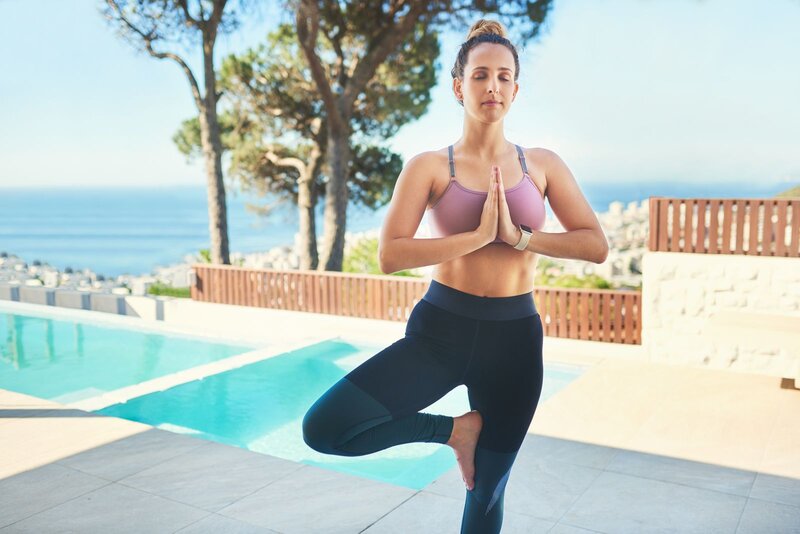
Yoga For Anxiety and Depression
Posted by Sienna Cabrera on 2023-02-13
Yoga has become a popular form of exercise for people dealing with anxiety and depression. This form of exercise has been known to help calm the nervous system and increase levels of GABA. The key to success with yoga is practicing in a calming and safe environment and doing the poses slowly.
Practice in a space that feels comfortable and safe
Yoga is a great exercise that can improve your mental state while giving you some much-needed self-awareness. A calming yoga session will work wonders for your mood, and you can do it at home if you desire.
There are several forms of yoga and some instructors may encourage you to try the challenging versions. Finding the right type of yoga for you may take some time, but a little practice will go a long way toward alleviating your anxiety symptoms.
The benefits of practicing a bit of yoga include increased stamina, better sleep, improved concentration, and a healthier lifestyle overall. It's also been proven that it can lower your blood pressure and reduce the chances of panic attacks. One study reported that people who practiced this form of relaxation reported feeling better about themselves.
Practice yogic breathing techniques
If you have anxiety or depression, yogic breathing techniques may help calm your mind. Yogic breathing is an ancient practice in India. It involves intentional breathing and is a great way to relax and energize the body.
Yoga breathing techniques are easy to learn, but you'll need to keep practicing them. Some techniques require guidance from a qualified yoga teacher.
There are several different breathing exercises that are effective for depression and anxiety. One type is called equal ratio breathing. This is inhaling for the same amount of time as exhaling. You should close your eyes and count your breaths when practicing this technique.
Another type is called alternate nostril breathing. In this form of pranayama, you open and close your right nostril while inhaling through the left. It would be best if you did this twice daily.
Regulate the autonomic nervous system
Yoga for anxiety and depression has a lot of potential to help you cope with stress, anxiety, and depression. It is not only beneficial to your mind but it has also been shown to have a positive effect on your body.
Fortunately, yoga for anxiety and depression is not as hard to come by as you might think. There are many instructional videos available on YouTube and most studios stream classes online. If you cannot find a class in your area, you can easily customize a practice at home.
Several scientific studies have cited yoga as a useful tool in treating anxiety, depression, and even insomnia. For instance, one study found that practicing yoga reduced symptoms by more than half. Another study found that participants who had participated in yoga had a more optimistic outlook on life.
Increase levels of GABA
Yoga is a powerful tool to increase levels of GABA in the brain. It has been shown to increase the production of a neurotransmitter, which can have a positive impact on anxiety and depression.
Many people have experienced a variety of mood disorders because they lack GABA in their bodies. Lack of GABA can cause anxiety, irritability, insomnia, nervousness, and difficulty with self-control.
Medications are a common option for relieving anxiety and depression. However, some of these medications can be harmful and lead to dependency. A more natural alternative is to increase levels of GABA with yoga.
GABA is an amino acid which is synthesized from vitamin B6. The neurotransmitter is used to keep brain cells from hyperactivity. Lack of GABA causes anxiety and depression.
Limitations of studies
Many studies have investigated the potential of yoga to treat anxiety and depression. While a majority of studies have shown positive results, some have limitations. Some have methodologic shortcomings, such as a lack of randomization and blinding, and some have had limited analysis.
A recent systematic review of yoga and anxiety concluded that it appears to be effective in improving symptoms of anxiety and depression. However, future studies should focus on identifying the most effective yoga-based interventions and describe the elements of yoga in detail. These elements may include breathing, relaxation, and physical yoga postures.
In the current review, the authors used a combination of clinical experience, exercise principles, and available evidence to examine the effectiveness of yoga in children and adolescents with anxiety and depression. The authors summarized 133 articles that were eligible for review. They examined studies with youth between the ages of eight and 18 that included standardized outcome measures, a physical yoga posture, and a yogic element.